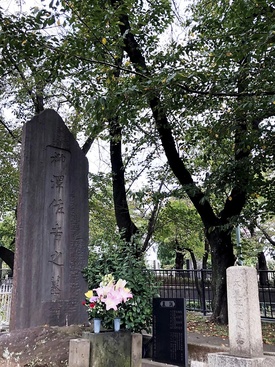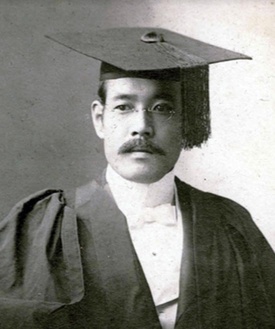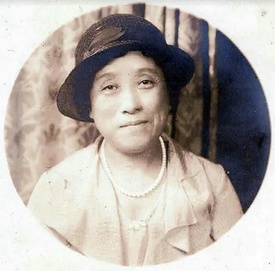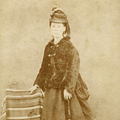Sakichi Yanagisawa, formerly of the Wakamatsu Colony, returned to Japan in 1902 and started to teach Western cooking at Japan Women’s University. According to the Naruse Memorial Museum at the university, he started working there as a contract teacher in September 1903 and probably retired in 1905.
Yone was teaching English at the university at the same time, and the school bulletin confirms the two of them were there.
Sakichi also wrote a book titled Nouji ni Kansuru Iken (Opinions on Agricultural Affairs) in 1903.
About three years after his return to Japan, Sakichi died in Kohinata-cho, Koishikawa-ku, Tokyo. He was 57 years old.
Sakichi raised his daughter to become the first Japanese woman to graduate from the University of California, after going through many hardships that he had to overcome such as the difficult time in the colony, racial barriers, and the death of his wife.
The long journey of a pioneer who lived through turbulent times came to an end in his homeland, Japan.
Yone’s Life in Japan
After returning to Japan, Yone taught English at Japan Women’s University from 1903 to 1905, at the Kokumin Joshi Gakkou (National Girls’ School) for two years from 1908, and at the Kokumin Ei Gakkai (National English Society) for 20 years from 1910.
From 1911, she worked for Sankyo Corporation as a contractor, and from 1912 she tought English at the Daiichi Gaikokugo Gakkou (First Foreign Language School) in Hongo, Tokyo. In 1911, she published a book on health, Ratai Seikatsu (Naked Life). She had also obtained a Japanese medical license.
In 1934, at the age of 60, Yone lived in a two-story wooden house in Koura-cho, Chiyoda, Tokyo and gave an interview to Nichibei Shinbun. She had a bookcase full of Western books in her house and had never lost her love for learning.
She said, “Nisei, second-generation Japanese Americans, are born in the U.S. and are U.S. citizens, but because they have a Japanese face, they are not hired by American companies. In Japan, even if a job is available, the salary is low and Nisei will be disappointed.”
This must have been her own experience in Japan and the U.S.. She also mentioned that “racial feelings existed,” conveying the harsh reality that Nisei had to face.
She was bilingual and was qualified as a doctor in both Japan and the U.S. However, despite her excellence, the Japanese and American societies at the time were cold toward her.
Records from Sankyo Corporation shows that Yone’s monthly salary in 1919 was 70 yen. This was equivalent to the starting salary of a national public servant with a university degree at that time, which in today’s terms is about 180,000 yen (about 1,580 U.S. dollars). This doesn’t seem like a high salary for a qualified doctor.
However, even in this situation, Yone put a lot of effort into teaching English to the next generation of women. When she was a young woman, she told an American newspaper reporter that she wanted to teach English in Japan in the future, and she made her dream come true.
Yone and Yosaku
After returning to Japan, Yone’s partner Yosaku worked not only as a dentist, but also as one of the funders of the Bei Yu Club, which was established to promote friendship among people who used to live in the U.S.
Yosaku was also active in supporting Japanese Americans in California, where the anti-Japanese movement was heating up. Unfortunately, he passed away on Dec. 6, 1909.
Yone and Yosaku remained in a common-law marriage until his death. They had no children and eventually, she adopted a son, Takeo, Ayako’s father and Kanako’s grandfather. The family line continues to descend from Takeo and his wife Shige.
Takeo was born on Oct. 1, 1911 and adopted in 1935 when he was about 24 years old.
“I heard that my grandfather Takeo was unable to go to college due to financial reasons and was adopted the same year he got a job at Mitsubishi Bank. I believe that Yone and Takeo are related in some way due to the inheritance of the family,” Kanako said.
Yone in Her Later Years
Although Yone was able to provide Takeo with a comfortable life, there was a promise between the two.
“Once a month, Takeo would take Yone to a fine Western restaurant with his own salary,” says Ayako.
Yone looked forward to going to the restaurant dressed in formal attire each time. She was so stylish that she even had a costume room in her house.
Going out to dinner with Takeo once a month, dressed up, was probably a precious moment for her, reminding her of her childhood in California, where she used to wear tailor-made clothes that her father had ordered for her.
Just before Yone’s death, Takeo’s wife, Shige, had a surprise. Yone’s hair was completely white. “My mother said that Yone had a number of wigs that she used for different purposes, such as eating out, going out, and for everyday use, and my mother never noticed that she had gray hair,” Ayako said. Shige, Ayako’s mother, lived with Yone and they kept a good relationship.
In response to the image of Yone that emerged, Kanako said, “Yone must have been a lovely person. Shige seems to have respected her very much. I’m sure Yone was happy to have spent her last years with Takeo and Shige.”
On March 10, 1942, the year after the Japanese attack on Pearl Harbor, Yone died at the age of 70 after catching a cold and falling ill. Her life was one of academic accomplishment in the U.S. and dedication to English education in Japan.
The Eternal Bonds of Family

Sakichi and Yone, a father and daughter who achieved great things in California, and Yosaku, whom Yone loved, now rest in peace at Aoyama Cemetery in Tokyo. There, in honor of their courage and pioneering spirit, their descendants have created a large tombstone to remember them.
Ever since Kanako wondered about the size of her ancestors’ grave, she has been interested in them, as if she were filling in a gap in her family history.
She said, “Sakichi must have had a life full of hardship. Yone’s life was not all smooth sailing either. However, I would be happy if people in Japan and the U.S. could know that they worked hard to live their lives even after returning to Japan. I want to pass on their story to the next generation.”
Nami, Sakichi’s wife, mother of Yone, and one of the first Japanese settlers in the North America, now rests in the land of California.
Even though they are 5,200 miles away from each other, the bonds of a pioneer family that lived through turbulent times will always remain strong and will never be broken.
* * * * *
The author wishes to extend her gratitude to those who assisted in creating this story, and to cite the extensive sources of historical information:
– “About ‘Gospel Society Historical Sources’” by Koujiro Iida
– California Digital Newspaper Collection
– California State Archives
– Dr. Lisa Hirai Tsuchitani, UC Berkeley
– Fumito Aihara, Shohei Ohya, Yokohama City Central Library
– Greenlawn Memorial Park
– Hoji Shinbun Digital Collection, Hoover Institution Library & Archives
– Japan Women’s University Naruse Memorial Hall
– Associate University Archivist Kathryn M. Neal, UC Berkeley
– “Meiji Taisyo Syoki ni Okeru Honpou no Kanzumegyou” by Touichi Tada
– Naomi Izakura, JCII Camera Museum
– “Protestant Denominations in California and Japanese Immigrants,” “The Formation of the Japanese Churches in California and E.A. Sturge in 1910s” by Ryo Yoshida
– Yokohama Archives of History
– Zaibei Nihonjin Shi
*This article was originally published on the Rafu Shimpo in January 19, 2022.
© 2022 Junko Yoshida / Rafu Shimpo









